‘We Don’t Do Video. We Do Television’: Indiana’s Jeffersonville High School Raises the Bar for Live Varsity Sports Production
A new Sprinter van complements robust control room supporting live broadcasts
Story Highlights
In an era when live-production and distribution technology has become ubiquitous and more accessible than ever, virtually anyone can produce a live broadcast. It takes a special level of commitment, however, to be truly great at it.
The emergence of in-house teams for live and post video-production has been well-documented across the collegiate landscape. Now stand-out video programs are popping up across the country at even the high school level.
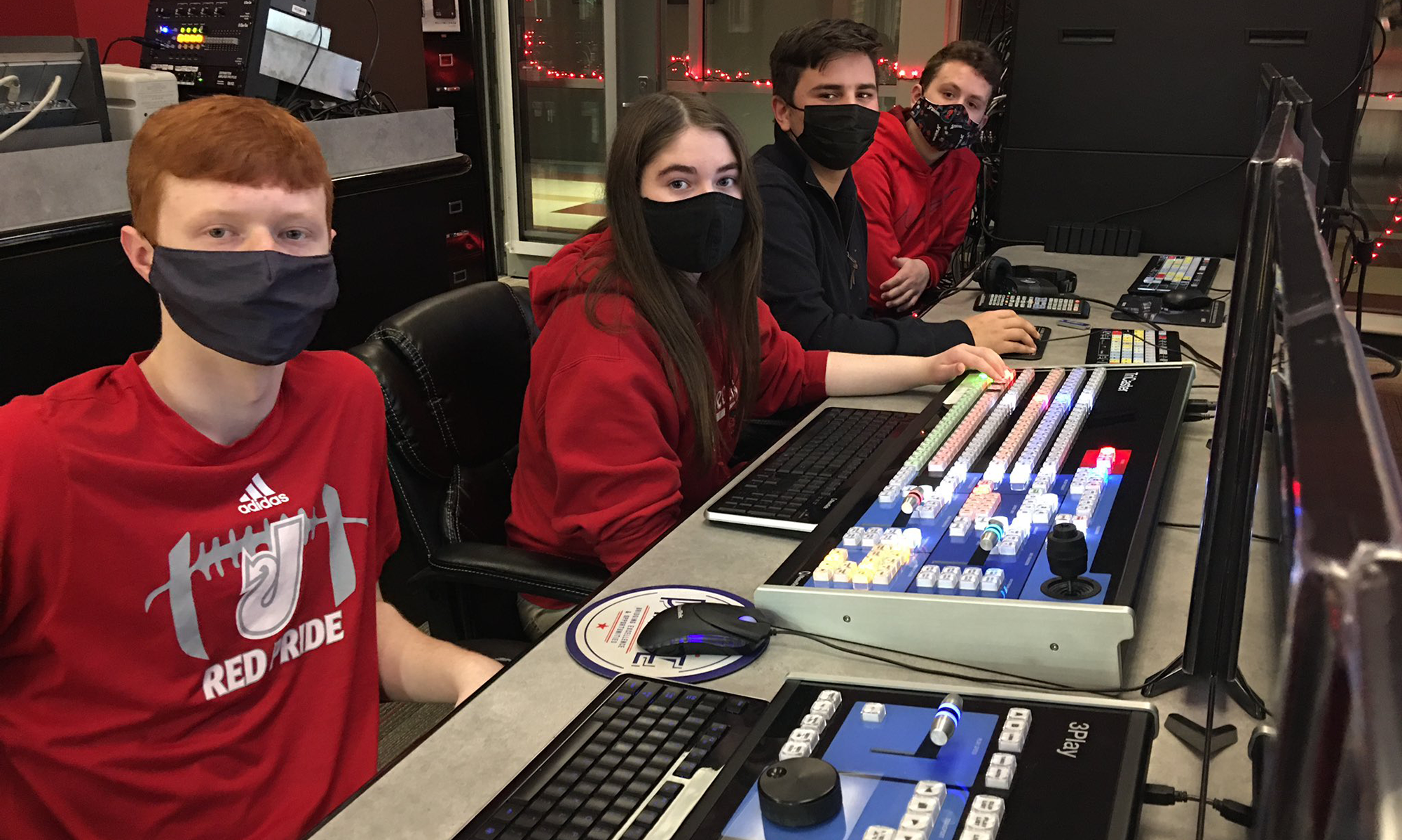
Jeffersonville High School’s WJHI puts students at every position of live sports productions: (from left) Alec Zabel, Julia Hoyer, Nathaniel Gardner, and Justin Haas produce a Red Devils basketball game. (All photos courtesy Jeffersonville High School)
One of those is the eye-popping program at Jeffersonville High School in Indiana.
Over the past five years, WJHI, as the program calls itself, has fine-tuned its ability to produce live coverage of the school’s athletics programs and established itself as an elite destination for students seeking a taste of life behind the scenes in live television production.
With a full-fledged control room, a talented crop of students, and a recently acquired Sprinter van for onsite production, WJHI demonstrates how success in live sports video — and access to opportunities in the field — is increasingly available for younger folks.
“We don’t do video. We do television,” says Jeffersonville High School teacher and WJHI Director Tim Dench. “That helps us stand out. Multiple cameras, replay, graphics: I think you are going to see more superintendents across the state and across the country looking at that.”
A Critical Connection
WJHI has a very simple slogan: “Radio/TV by the students, for the community.”
The core value of civic duty has never been more evident than during the COVID-19 pandemic, when many athletic events across the country have been forbidden to host spectators in the stands.
Through WJHI, Red Devils sports events can be seen live on a local cable channel, on closed-circuit television at various points on the high school’s campus, and streaming on the IHSAA Champions Network (which is run by the state’s high school athletics association) and can be heard streamed through the school’s FM radio station. Every live broadcast is available in some form for free.
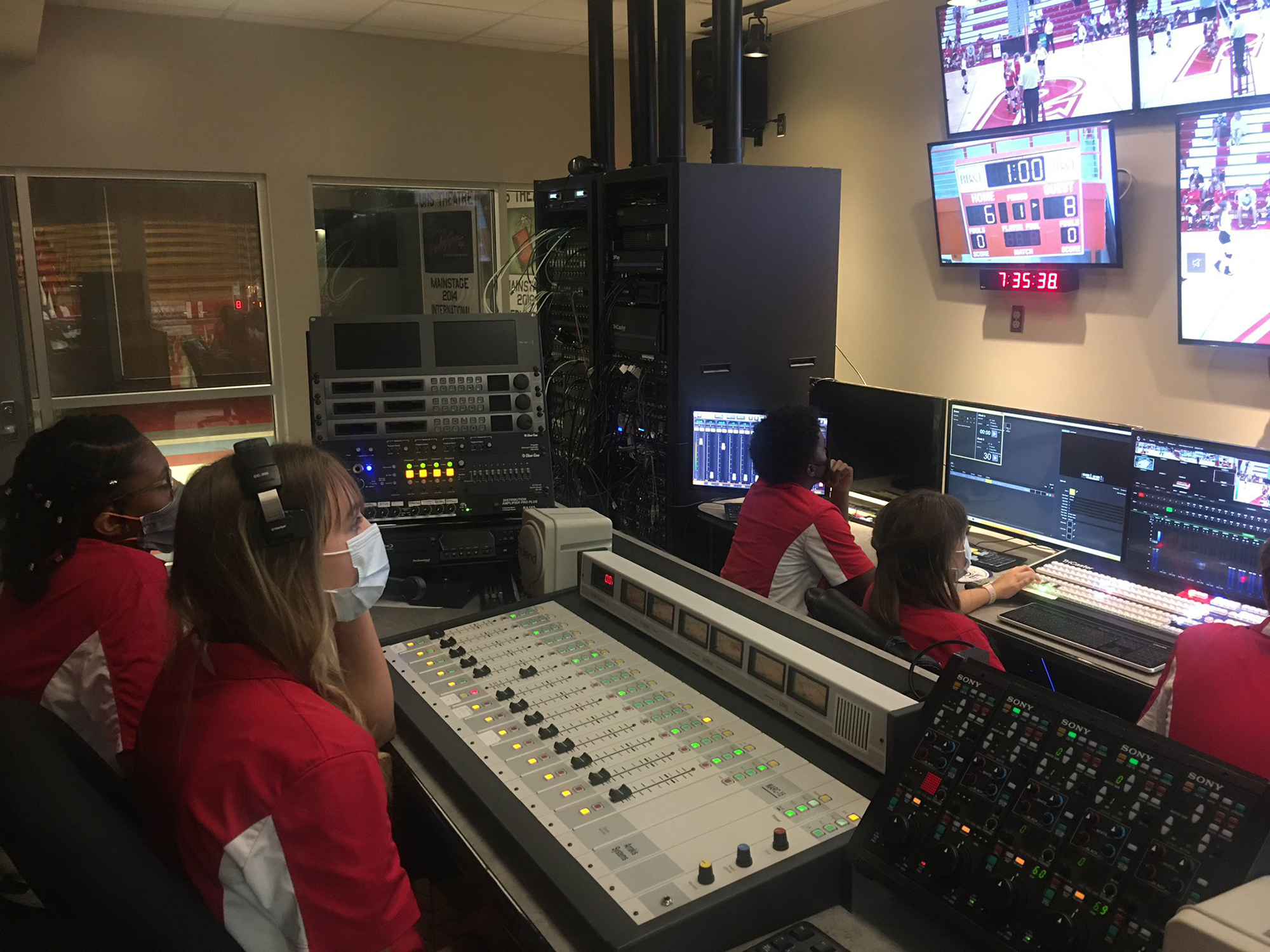
WJHI students produce live broadcasts from a robust control room in Jeffersonville High School: (back row, from left) Karah Lambus, Lily Fondrisi; (front row, from left) Ashton Davis, Jasmine Fondrisi
“We are more important than ever,” says Dench, noting that WJHI has produced live coverage of every single event that has taken place in the school’s gym since August. “People literally can’t get into the building to watch sports, and, without us, they couldn’t see anything. We are becoming the valuable tool for the community that we thought we would be when we started this station.”
The wide array of distribution platforms is a huge benefit for the students on the productions. With more Red Devils athletics events broadcast, more crew members have live shows to produce.
“I don’t see a world after COVID where everything is not streamed,” says WJHI Sports Director Clay Ables, who also works locally as a freelance on-air broadcaster. “In our area, I don’t know anybody who’s not streaming any sport. It’s getting that way in high schools, too. This opens up a lot of opportunities for students.”
Staying committed to serving the people of Jeffersonville is easy when the community is supportive of the program. With COVID restrictions, students couldn’t go out to solicit local businesses for advertising revenue, which funds much of the day-day to operations of WJHI. Through local resources, individuals & businesses, WJHI received nearly $20,000 in donations in a single day.
“We appreciate so much what the community has done for us,” says Dench.
Growth Despite Restrictions
In this academic year, WJHI is staffed by about 75 students, who have been able to remain active thanks to COVID-related health and safety processes and protocols.
Students get the opportunity to rotate and gain experience in every part of a production: running cameras, directing at the front bench, running graphics or replay, even announcing on-air.
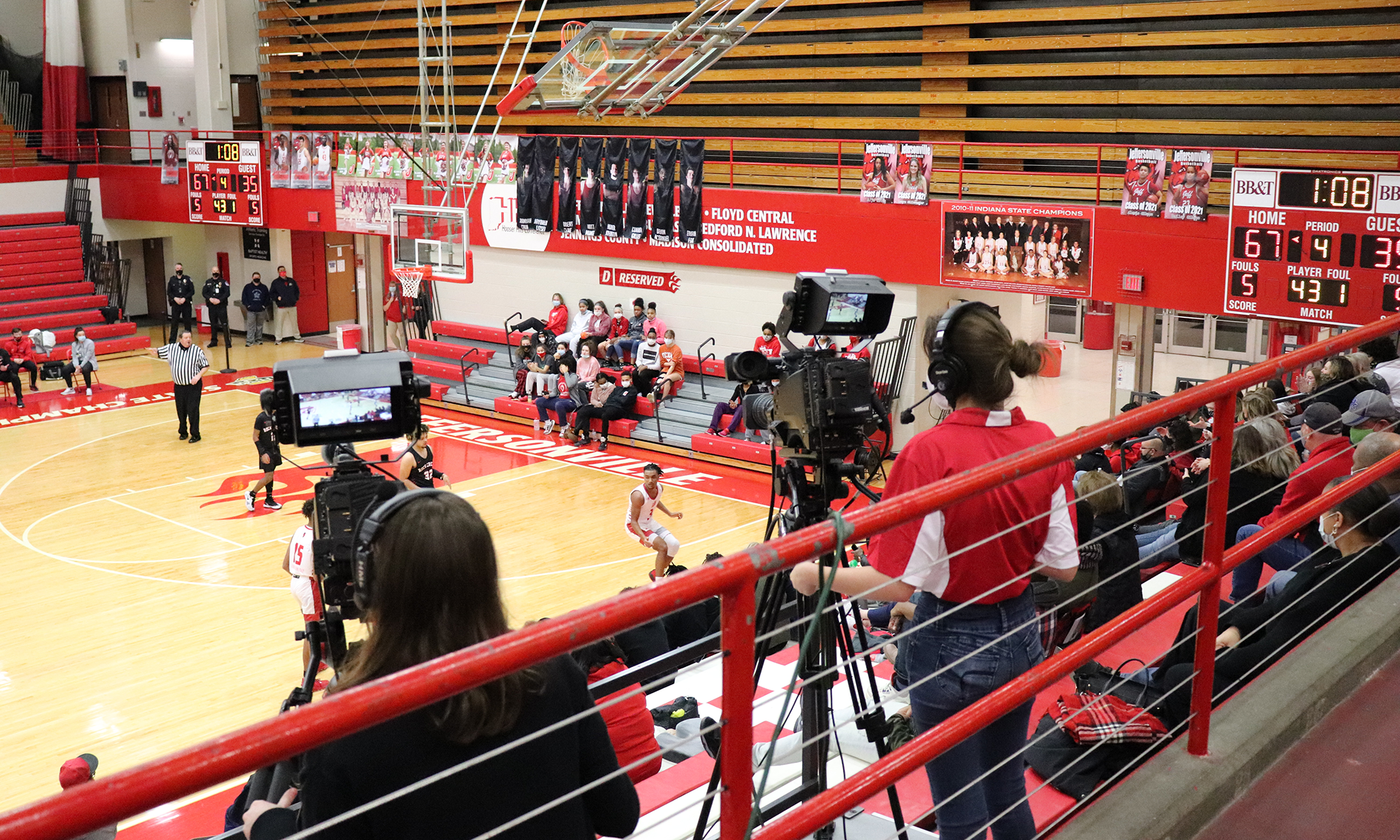
Students have been able to safely run cameras during the pandemic. Here, Caroline Shepherd (left) and Kirstin Elder shoot a basketball game.
Distancing, cleaning, and aggressive rotation of students have helped keep WJHI moving during the pandemic. Training students and keeping them engaged has been a challenge met by the faculty, and regular rotation has allowed freshmen and sophomores the chance to get far more reps than they would have in normal circumstances.
“The creativity hasn’t been the tough part; it’s the scheduling,” says Ables. “There are so many revisions with COVID safety, snow, whatever it may be. Thankfully, the school has been very giving in that we haven’t had to change our productions too much. The toughest part is simply staying on schedule. The kids need a rhythm and to be there consistently to learn.”
WJHI training has also adapted to the pandemic by integrating the changes seen in the current sports-broadcasting industry. For example, student on-air announcers are starting to be taught how to call games off a TV screen in the WJHI studios, reflecting the current trend of calling games in-studio.
“Our kids have a lot of experience that nobody else has,” notes Dench.
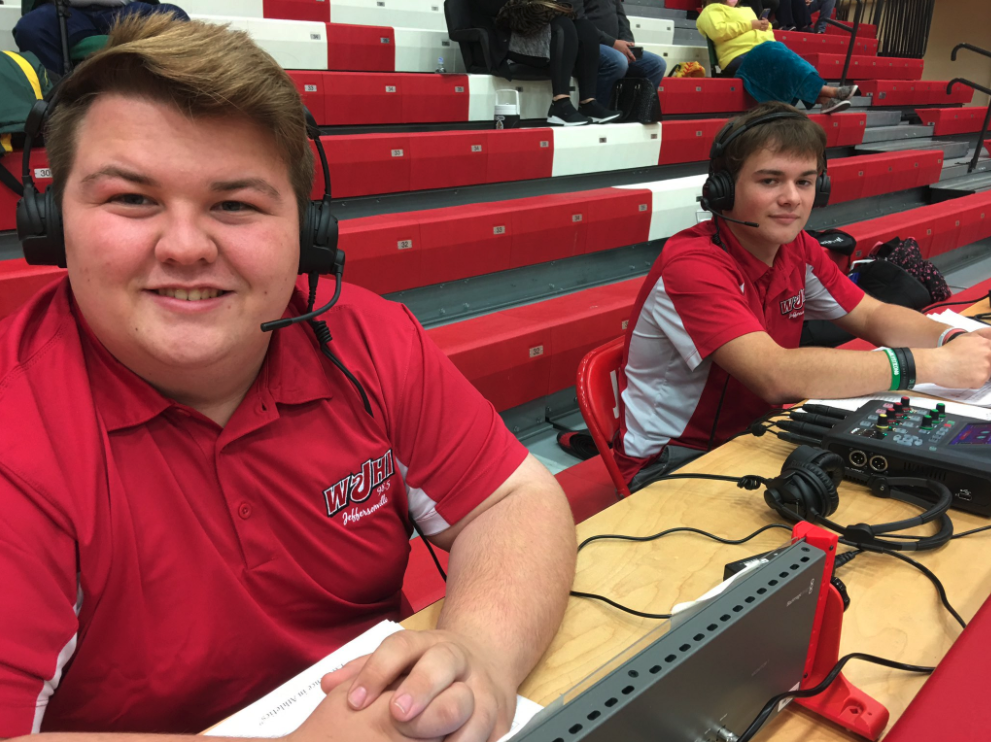
Two of WJHI’s top on-air announcers, Wyatt Williams (left) and Chaz Waters (right), call a Jeffersonville boys’ basketball game.
The training and experience has already churned out an impressive list of alumni: for example, Phillip Steinmetz, an Indiana High School Press Association Sports Journalist of the Year in 2017, currently serving as sports editor of the University of Indiana’s Daily Student; Faith Dening, a two-time regional Emmy winner and SVG College Sports Media Award winner at Ball State University; Luke Astle, a regional Emmy winner who was also the first high school student to serve as a paid professional broadcaster for ACCN X; Dylan Thompson, head of athletic video, Robert Morris University; Christian Watson, creative-content developer for Louisville-based Extol magazine; Jarod Jones and Anna Lowe, students working with Ball State Sports Link at Ball State University; and Micah Rodriguez, a student at the Savannah School of Art and Design.
Robust Resources
Although the school has been adapting over the past year, the facilities that WJHI built over the past five years rivals those of some high-end collegiate programs.
WJHI’s control room is loaded with resources aimed at training the next generation of live-sports-production professionals. The lineup features a NewTek Tricaster 8000 production switcher, Graphic Outfitters ScoreFX for live graphics integration, ClearCom IFB and intercom systems, Samsung LED monitors, an Inovonics 730 RDS encoder, and Tascam SS-R200 and CDR-200 digital players and recorders to archive everything. For live coverage, WJHI deploys Sony Broadcast cameras with 20X lenses equipped with doublers for 40X closeups.
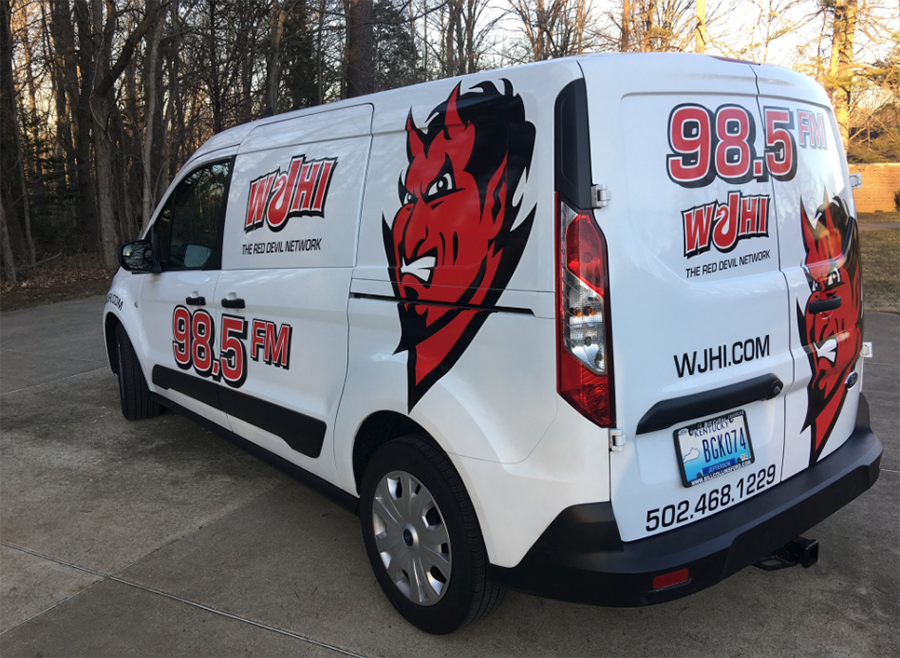
WJHI recently unveiled its remote-production Sprinter van. It will be used for live coverage of events in the community or in parts of the school not fiber-connected to the main control room.
monitors, Neumann BCM 705 microphones, and Sennheiser HME 26-II headsets.
Jeffersonville is also the only high school in the country using the DJB Radio Zone software-based production suite, according to the supplier.
Elsewhere on campus, major additions include a brand-new football stadium, whose press box WJHI staff helped outfit. That press box comprises a broadcast booth and 48 strands of fiber connecting it to the TV-control room in the school. There are fiber drops at the 50-yard line, both 20-yard lines, and both end zones. In addition, there are two fiber drops at the top of the press box, a setup many colleges would envy. So far, one game has been played in the stadium; fittingly enough, it was a state sectional playoff game that the Red Devils won.
In the school’s 1,000-seat auditorium is a digital 4K projector, and connections to the WHJI control room allow video productions to be fed directly to the screen. It will prove useful for students and family barred from the stands for social-distancing reasons and will serve as overflow for graduation and high-profile sports events when things return to normal over the next year.
And then, there’s the latest addition: the new Sprinter van that the students will begin using soon.
“Our school has been moving forward despite COVID,” says Dench. “We are not slowing down at all.”
